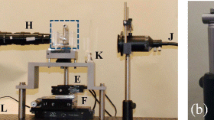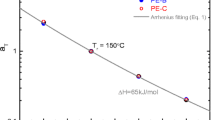Abstract
A technique has been developed to assess elasticity in extension of fluids which are weakly elastic. The technique is based on stretching a fluid sample held between two small closely spaced co-axial disks until the fluid bridge or filament breaks. The distance between the disks on breakup, ‘the breaking length’, is measured. When the fluid is elastic, this length is greater than that of an equivalent inelastic fluid. An inelastic baseline was established by measuring the breaking lengths of a wide variety of Newtonian fluids. Measurements with weakly elastic fluids reveal that the extra breaking length increases with polymer type and concentration and with the rate of stretching, the expected behavior for elastic liquids. The breaking lengths of model paper coatings were measured and found to correlate with the degree of misting in a roll coating machine, indicating that droplet formation is related to extensional elasticity.










Similar content being viewed by others
References
Anna SL, McKinley GH (2001) Elasto-capillary thinning and breakup of model elastic liquids. J Rheol 45:115–138
Anna SL, McKinley GH, Nguyen DA, Sridhar T, Muller SJ, Huang J, James DF (2001) An interlaboratory comparison of measurements from filament-stretching rheometers using common test fluids. J Rheol 45:83–114
Arnould JP, Zahm JM, Potter G, Duvivier C, Puchelle E (1984) A new apparatus for measuring the thread-forming property (spinnability) of biological fluids. Biorheology 1:123–126 (Suppl)
Fernando RH, Xing L-L, Glass JE (2000) Rheology parameters controlling spray atomization and roll misting behavior of waterborne coatings. Prog Org Coat 40:35–38
Gaudet S, McKinley GH, Stone HA (1996) Extensional deformation of Newtonian liquid bridges. Phys Fluids 8:2568–2579
Gillette RD, Dyson DC (1971) Stability of fluid interfaces of revolution between equal solid circular plates. Chem Eng J 2:44–54
Hyder MN (2003) Statics and dynamics of liquid bridges. MASc thesis, University of Toronto
James DF (1975) A method for measuring normal stresses in dilute polymer solutions. Trans Soc Rheology 19:67–80
James DF, Sridhar T (1995) Molecular conformation during steady-state measurements of extensional viscosity. J Rheol 39:713–724
James DF, Yogachandran N, Roper JA III (2003) Fluid elasticity in extension, measured by a new technique, correlates with misting. Proceedings of 2003 TAPPI 8th Advanced Coating Fundamentals Symposium, May 8–10, Chicago
Jones WM, Walters K, Williams PR (1987) On the extensional viscosity of mobile polymer solutions. Rheol Acta 26:20–30
Macosko CW (1994) Rheology, principles, measurements and applications. Wiley, New York
Rubin BK (1999) An in vitro comparison of the mucoactive properties of guaifenesin, lodinated glycerol, surfactant, and albuterol. Chest 116:195–200
Sadeghy K, James DF (2000) Elasticity of associative polymer solutions and slip at high shear stress. J Non-Newton Fluid Mech 90:127–158
Segal J (2005) Rheological properties of fibre suspensions. MASc thesis, University of Toronto
Terrapon VE, Dubief Y, Moin P, Shaqfeh ESG (2004) Simulated polymer stretch in a turbulent flow using Brownian Dynamics. J Fluid Mech 504:61–71
Tirtaatmadja V, Sridhar T (1993) A filament stretching device for measurement of extensional viscosity. J Rheol 37:1081–1102
Wang J (2003) Droplet formation from simulated film splitting. MASc Thesis, University of Toronto
Zahm JM, Puchelle E, Duvivier C, Didelon J (1986) Spinnability of respiratory mucous, validation of a new apparatus: the filancemeter. Bull Eur Physiopathol Respir 22:609–613
Acknowledgements
Gareth McKinley of M.I.T. made us aware of the ‘filancemeter’ and pointed out that fluid strain at the breaking point goes to infinity. He also reviewed the manuscript in detail and kindly suggested ways to improve it. In our laboratory, Ayse Thomson made visual measurements of the breaking length, confirming those made using the laser beam, and Neda Felorzabihi carried out the drag reduction experiment. The support of this work by the Natural Sciences and Engineering Research Council of Canada and by the Pulp & Paper Centre at the University of Toronto is gratefully acknowledged.
Author information
Authors and Affiliations
Corresponding author
Rights and permissions
About this article
Cite this article
James, D.F., Yogachandran, N. Filament-breaking length—a measure of elasticity in extension. Rheol Acta 46, 161–170 (2006). https://doi.org/10.1007/s00397-006-0120-4
Received:
Accepted:
Published:
Issue Date:
DOI: https://doi.org/10.1007/s00397-006-0120-4




